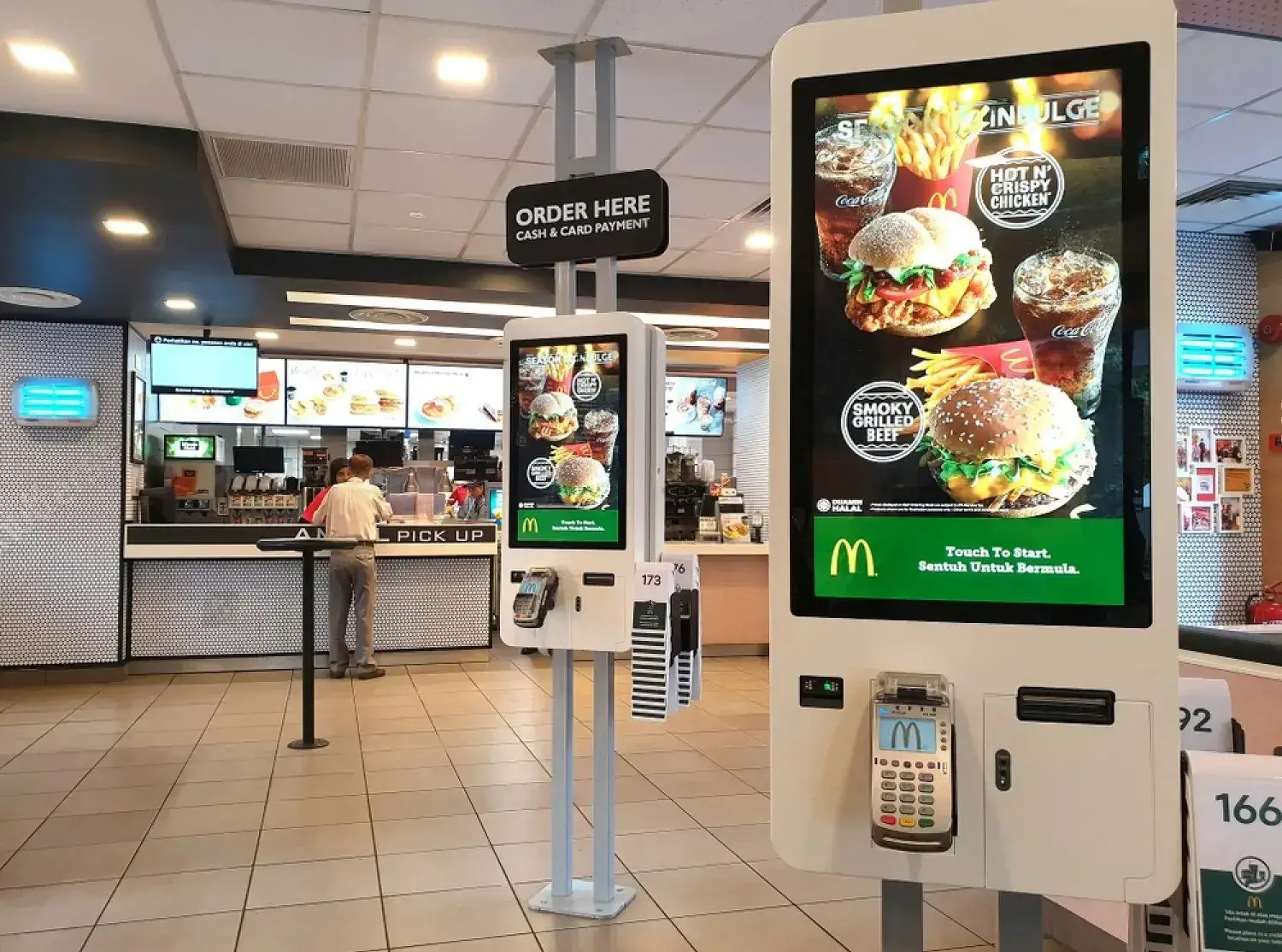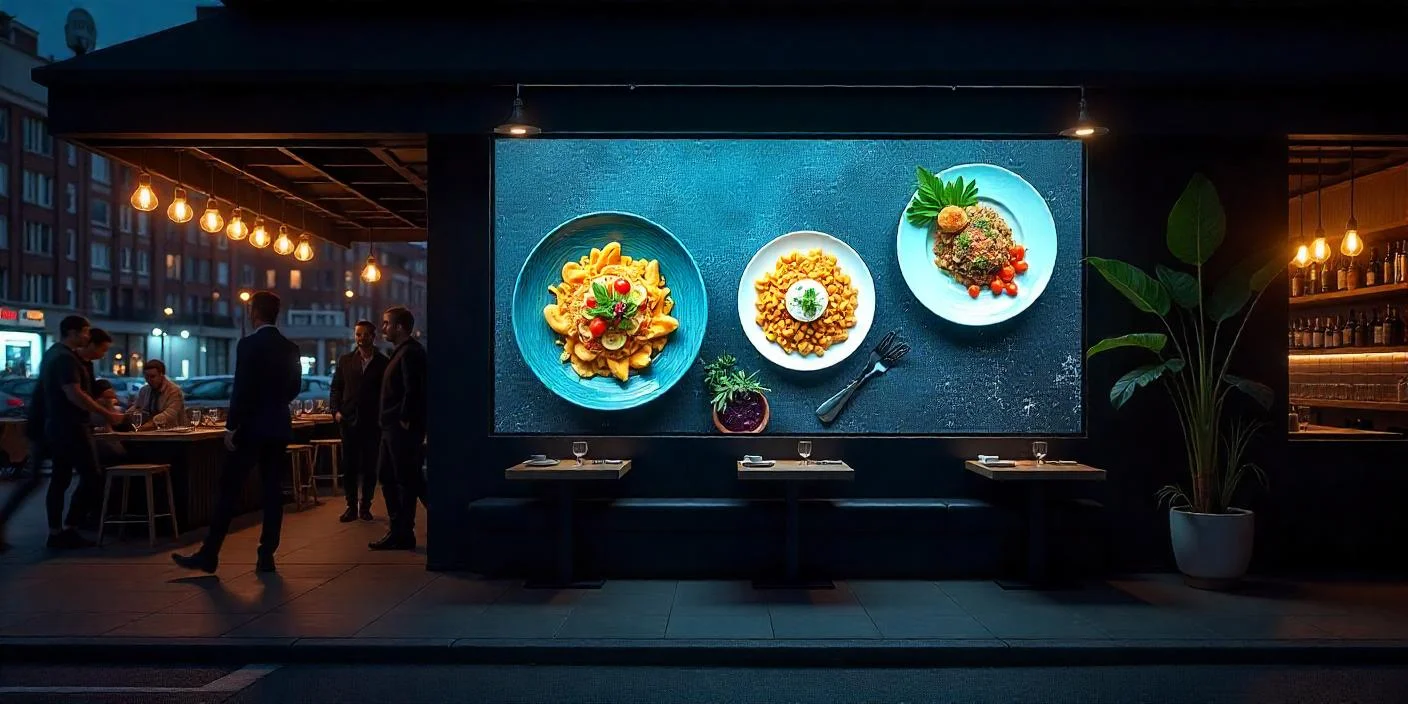In the hectic food service business, food service digital signage has become more of a requirement than a luxury. Whether you need to simplify orders at a quick-service chain by using outdoor digital menu boards or you want to enhance the atmosphere at a fine-dining restaurant with the help of digital signage menus, contemporary digital signage solutions can provide guests with engaging, real-time content that will improve every interaction they have. With the ability to upsell items, decrease perceived wait times, and enforce brand identity all through one centralized, cloud-based dashboard, operators can achieve all of this through the integration of powerful digital signage software, integrated restaurant point-of-sale systems, and attractive digital menu board design.
Benefits of Digital Signage for Restaurants
Enhanced Customer Engagement
Full-color animations, drool-worthy videos of chef specials, and scrolling digital menu solutions will attract the eye much more than a printed menu will. Digital signage player software running on interactive kiosks encourages guests to explore and personalize orders and even enroll in loyalty programs.
Real-Time Content Updates
Have to advertise a noontime special or eliminate an item that has sold out? Using cloud-driven digital signage software, managers can send updates in real-time to all locations, whether it is an indoor lobby display or an outdoor digital menu board, to guarantee pricing and promotional flexibility.
Reduced Wait Times
Restaurant queues are a good place to place digital signage screens that inform and entertain. You can turn perceived downtime into an exciting brand experience by displaying order status, nutritional highlights, and social media feeds using your restaurant hashtag.
Upselling Through Visual Appeal
The digital menu boards in high definition that display high-quality add-ons and combo recommendations motivate diners to add more to their orders without requiring additional staff intervention. Using digital signage systems analytics, data-driven prompts appear on screens at the right time with high-margin items.
Types of Digital Signage Systems in Food Service
Indoor Digital Signage Displays
Dynamic digital menu boards, promotional loops, and day-to-day specials are shown on behind-the-counter screens and tabletop tablets. These units are mounted or free-standing and are connected to restaurant POS systems to facilitate order fulfillment.
Outdoor Digital Menu Boards
Designed in drive-thrus and patio, high-brightness, weather-proof LED panels provide excellent visibility even in sunlight and rain. These units, when coupled with digital signage software, implement menu changes, price updates, and targeted advertisements in real time.
Kiosk-Based Interactive Screens
Self-order kiosks Self-order kiosks are a combination of digital signage menus and touch screens that help to cut down labor expenses and enhance the accuracy of orders. They are linked to back-end POS and inventory databases and automatically deduce items that are out of stock, as well as implement loyalty discounts on the fly.
Digital Signage Menus: Revolutionizing Menu Presentation
Flexibility in Menu Updates
Using digital signage food menu systems, changing seasonal items, happy-hour items, or holiday items can be done in seconds. With centralized control, consistency is applied to all your food service deployments with digital signage.
Visual Storytelling Through Imagery
These menus go beyond text to engross the guest in your brand story: the source of your ingredients, profiles of your chefs, and prep videos behind the scenes. It is a rich media strategy that generates emotional attachments and repeat traffic.
Integration with Restaurant POS Systems
A top digital signage solution should be bi-directionally integrated with your POS and inventory. This makes sure that the prices, nutritional information, and stock are up to date on all digital menu boards, which minimizes errors and wastage, as well as allows dynamic pricing strategies.
Choosing the Best Digital Signage for Food Service
Hardware Considerations
Choose commercial-grade displays with the correct brightness (1,500 2,500 nits outdoor), size (32″ 75″), and mounting to suit your venue: drive-thru canopy, lobby wall, or countertop kiosk.
Software Capabilities
Choose a cloud-native digital signage software with a multi-location scale, role-based access, API integrations (POS, CRM, social media), and real-time analytics dashboards.
Features to Look for in Digital Signage Software
Remote Content Management
Centralized dashboards allow marketing teams to update menu boards and promotions remotely, ensuring brand consistency across all outlets.
Automation and Scheduling
Schedule content swaps, such as breakfast to lunch menus, daily specials, or limited time offers, and remove the manual process and human error.
Analytics and Performance Insights
Built-in metrics can be used to measure dwell times and interaction rates on touchscreens as well as promotion performance. These understandings are used in menu enhancement and direct promotional efforts.
Cost-Efficiency and ROI of Digital Signage
The best digital signage in food service may carry a hefty initial investment tag, but the returns on investment in the long term are hard to ignore: less printing and labor expenses, more upsell income and more customer loyalty. Operation overhead is also reduced with energy-efficient LED screens and cloud-managed systems.
Digital Signage for Fast Casual vs. Fine Dining
Fast-casual restaurants take advantage of the digital signage menu boards to make quick decisions and turnover, with large fonts and combo nudges. Fine dining restaurants, in turn, use classy digital screens to communicate the atmosphere, wine matches, and chef stories using more relaxed, film-like content.
Compliance and Accessibility in Digital Signage Menus
Make interactive displays ADA-compliant by using high-contrast text and legible fonts, as well as making them screen-reader compatible. Support of multiple languages is something that increases accessibility to various groups of customers.
Case Studies: Digital Signage in Action
- A national burger chain increased combo sales by 22 percent with targeted upsell animations on digital signage menus.
- A small coffee shop boosted iced drink orders by 30 percent when they incorporated live weather information into their restaurant digital signs.
- A sushi bar minimizes walk-outs by showing real-time wait list changes on lobby TVs connected to their POS.
Marketing and Branding with Digital Signage
Restaurant digital signage can be much more than a menu: it is an interactive marketing canvas, highlighting sustainability efforts, local collaborations, user-generated content, and social media walls, which can build communities.
Common Challenges and How to Overcome Them
- Content Fatigue: Switch up themes, use free restaurant templates, and add UGC to refresh screens.
- Technical Glitches: Choose a stable vendor with strong uptime SLAs and remote monitoring of digital signage services.
- Training the Staff: Offer short practical lessons to staff on your digital signage system so that they become the first responders to minor problems.
Future Trends in Digital Signage for Restaurants
- AI-Powered Personalization: The content changes depending on the time of day, customer demographics, or predictive analytics.
- Voice-Activated Kiosks: Voice-activated kiosks will improve accessibility and hands-free ordering.
- AR Dish Previews: Enabling the guests to see the 3D rendering of the menu items prior to ordering.
- Blockchain Transparency: QR-linked digital menus showing the provenance of ingredients.
Measuring Success with Digital Signage for Food Service

- Sales Uplift Analysis: Determine upsell rates by individual digital signage menu campaigns.
- Engagement Metrics: Measure dwell time, touch interaction, and click-throughs on interactive kiosks.
- Operational KPIs: Track the improvements in order accuracy rates and decreased costs of printing.
- Content Turnover: Track how often content is refreshed to promote nimbleness and relevancy.
Take the Next Step with Digital Signage for Food Service
Are you prepared to update the customer experience in your restaurant? Team up with a top digital signage provider of digital signage systems and digital signage software designed specifically to work within food service. Our end-to-end digital signage solution includes eye-catching digital menu boards specifically designed to serve the restaurant industry, as well as interactive digital signage software and full integration with restaurant POS systems to provide real-time updates, operational efficiency, and measurable ROI. Request a demo today and see why the best food service digital signage is the secret to building your brand, satisfying guests, and generating revenue.
FAQs
What is digital signage for food service?
A system of digital screens and CMS software to display menus, offers, and interactive content in food service settings.
How does digital signage integrate with POS systems?
Via APIs or integrated connectors, make sure pricing, stock levels, and orders are synced in real-time across all screens and terminals.
Are outdoor digital menu boards worth the investment?
Yep- tough, high-bright panels mean visibility and up-time in any weather, driving drive-thru throughput and customer satisfaction.
Can small cafés benefit from digital signage?
Absolutely. The low-cost digital signage systems and freeware digital signage software pilots allow small establishments to enjoy the benefits of modern menus and targeted promotions.
How do I maintain content freshness?
Automate daily specials, rotating promotions, and seasonal showcases using the scheduling and remote management capabilities of your digital signage software.








